CPlane
| Toolbar | Menu |
|---|---|
|
|
View / Viewport title Set CPlane |
The CPlane command sets the origin and orientation of the construction plane in the active viewport.
A construction plane is like a tabletop that the cursor normally moves on. The construction plane has an origin, x and y axes, and a grid. The construction plane can be set to any orientation, and each viewport’s construction plane is independent of those in other viewports.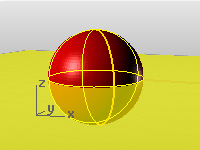
The construction plane represents the local coordinate system for the viewport and can be different from the world coordinate system.
Rhino’s standard viewports come with construction planes that correspond to the viewport. The default Perspective viewport, however, uses the world Top construction plane, which is the same construction plane that is used in the Top viewport.
Steps
- Pick a new origin point or choose an option.
| Command-line options | |
|---|---|
|
The construction planes in all viewports change so their origin is at the picked location. |
|
|
|
The Curve option sets the construction plane perpendicular to a curve. Curve steps
Note
|
|
Type subcrv to select part of a curve as input. |
|
|
|
The Elevation option changes the elevation (z direction) of the construction plane. Elevation steps
Note
|
|
Gumball |
The Gumball option sets the construction plane to match the gumball orientation of the currently selected object. |
|
|
The Object option sets the construction plane in the active viewport to an object. Object steps
|
|
|
The Rotate option rotates the construction plane. Rotate steps
|
|
|
The Surface option sets the construction plane to match a surface. The placement is constrained so that the construction plane is tangent to the surface. Surface stepsSurface optionsFlipReverses the direction. IgnoreTrimsUses entire untrimmed underlying surface. |
|
Moves the construction plane in the current viewport in its z direction, so its xy plane intersect the selected point. Through steps
Through optionAllMoves the construction planes in all viewports in their z directions, so their xy planes intersect the selected point. |
|
|
|
Sets the construction plane in the active viewport parallel to the view. View steps
|
|
Restores the specified default construction plane. World steps
|
|
|
|
The 3Point option sets the construction plane in the active viewport by specifying points to establish the x, y, and z directions. 3Point optionsVerticalSets the construction plane perpendicular to the current construction plane. ZAxisSets the construction plane z axis direction. |
|
|
Restores the previously used construction plane in the current viewport. Undo steps
ShortcutShift + Home |
|
|
Restores the construction plane that was active before the Undo option was used. Redo steps
ShortcutShift + End |
|
Toolbar |
Menu |
Status bar |
|---|---|---|
|
|
Auto CPlane |
The AutoAlignCPlane command turns Auto CPlane on/off and manages the related options.
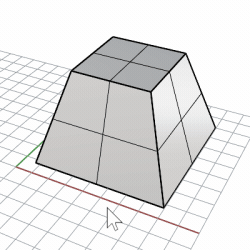
-
When Auto CPlane is enabled, the CPlane in the current viewport automatically aligns with the selected geometry. It works with a planar curve or surface edge, as well as a surface or sub-surface, which can be either planar or non-planar.
When Auto CPlane is turned on, the CPlane in the current viewport automatically aligns to a selected curve, surface edge, surface, or sub-surface. The curve and surface edge have to be planar, while the surface or sub-surface can be either planar or non-planar.
-
Auto CPlane can be toggled on/off by clicking the Auto CPlane pane on the status bar.
-
If the selected curve or surface is coplanar with the current CPlane, or the surface has a seam, Auto CPlane will not activate.
-
In parallel viewports, Auto CPlane will not activate if the view angle to the CPlane is lower than 15 degrees.
-
The AutoAlignCPlane command can be run nested in other commands to change options from the command-line.
-
Auto CPlane orientation is view related by default. If you like Auto CPlane to orient consistently on an object, you can disable OrientAutoCPlaneToView in Advanced settings.
Command-line options
Enabled
Turns Auto CPlane on/off .
- Clicking the Auto CPlane pane on the status bar toggles this option on and off.
Mode
The alignment mode can also be set by right-clicking the Auto CPlane pane on the status bar.
Object
Aligns the CPlane with the plane of the selected curve or surface.
World
Attempts to keep the X and Y axes of the CPlane aligned with the closest world axes.
View
Attempts to keep the CPlane Y aligned with the camera up of the view.
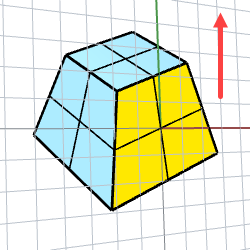
Cycle
Changes the alignment mode through Object, World, and View.
Keyboard: Ctrl(CMD)+R
Locked
Locks the CPlane to the current position and orientation.
Keyboard: Ctrl(CMD)+1
-
The Locked option is only available when an Auto CPlane is active before the AutoAlignCPlane command runs.
-
The lock
 /
/ icon on the Auto CPlane pane indicates the current locking state.
icon on the Auto CPlane pane indicates the current locking state. -
Click on the lock icon to toggle the locking state.
-
Sticky
The CPlane stays on the previously selected planar object/sub-object until another one is selected.
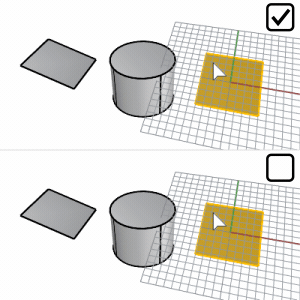
Example of using Auto CPlane
-
Click Auto CPlane on the status bar to enable Auto Aligned CPlane.
-
Use Sub-object selection to select a face on a polysurface by Ctrl(CMD)+Shift+Click.
-
Draw a circle.
The circle is co-planar with the face.
-
Deselect the face.
-
Select another face on the polysurface.
-
Draw a circle.
The second circle is co-planar with the second face.
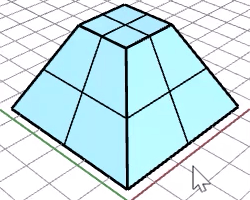
| Toolbar | Menu |
|---|---|
|
|
|
The CopyCPlaneToAll command changes all viewports to have the same construction planes as the specified viewport.
| Toolbar | Menu |
|---|---|
|
|
|
The CopyCPlaneSettingsToAll command changes all viewports to have the same grid settings and snap spacing as the specified viewport.
See also
MPlane
Set up a relationship between a construction plane and an object.
NamedCPlane
Manage the named construction planes list.
